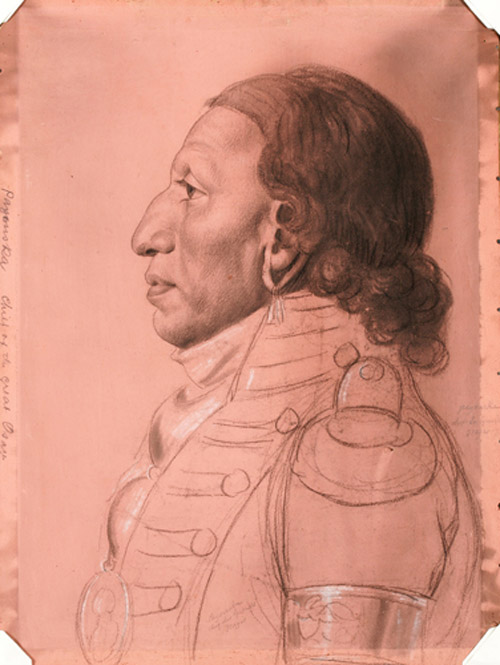Based on his letter of 18 February, Lewis likely follows through on his promise to join Clark in St. Louis today. There, he helps Pierre Chouteau organize an Osage delegation bound for Washington City.
Payouska (White Hair, c. 1752-1832)
Chief of the Great Osage (1804)
New-York Historical Society, 1860.92.
In Washington City, Charles B. J. F. de Saint Mémin, (1770–1852), painted four of the Osages traveling with Pierre Chouteau. Here, Payouska dons an Indian peace medal and military uniform coat (see Uniforms).[1]William R. Swagerty, The Indianization of Lewis and Clark (Norman, Oklahoma, The Arthur H. Clark Company, 2012), 2:620–21.
Lewis Joins Clark
Camp at River Dubois.
Feby. 18th 1804.My Dear Friend,
. . . .
I am as anxious as Mr. C. [Pierre Chouteau] can be that he should set out on this mission as early as possible, and shall therefore be with you the day after tomorrow for the purpose of conscerting the necessary measures.
. . . .
M. LEWIS. Capt. &c.[2]Lewis to Clark. Donald Jackson, ed. Letters of the Lewis and Clark Expedition with Related Documents: 1783-1854, 2nd ed., (Urbana: University of Illinois Press, 1978), 168.
Weather Diary
Therm at rise
weather wind Therm at 4 Oclk weather wind River 10 above 0 fair N W 28 above 0 S.S.W fall 2 ½ in. —William Clark[3]To assist the reader, the editor of this web page has omitted the “day of month 1804” column, merged the “River” columns, and spelled out some abbreviations.
Experience the Lewis and Clark Trail
The Lewis and Clark Trail Experience—our sister site at lewisandclark.travel—connects the world to people and places on the Lewis and Clark Trail.
Plan a trip related to February 20, 1804:

Winter Camp at Wood River (Camp Dubois) is a High Potential Historic Site along the Lewis and Clark National Historic Trail managed by the U.S. National Park Service. The site, near Hartford, Illinois, is managed as Lewis and Clark State Historic Site and is open to the public.
In present St. Louis, the Jefferson National Expansion Memorial “commemorates Thomas Jefferson’s vision of the continental expansion of the United States” and is a High Potential Historic Site along the Lewis and Clark National Historic Trail managed by the U.S. National Park Service.
Notes
| ↑1 | William R. Swagerty, The Indianization of Lewis and Clark (Norman, Oklahoma, The Arthur H. Clark Company, 2012), 2:620–21. |
|---|---|
| ↑2 | Lewis to Clark. Donald Jackson, ed. Letters of the Lewis and Clark Expedition with Related Documents: 1783-1854, 2nd ed., (Urbana: University of Illinois Press, 1978), 168. |
| ↑3 | To assist the reader, the editor of this web page has omitted the “day of month 1804” column, merged the “River” columns, and spelled out some abbreviations. |



